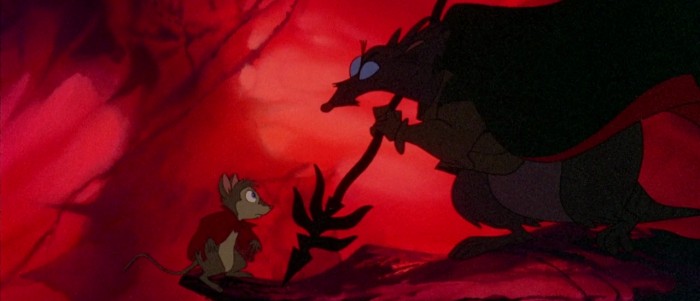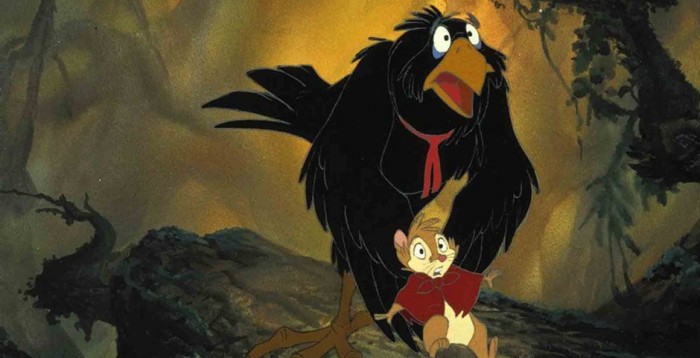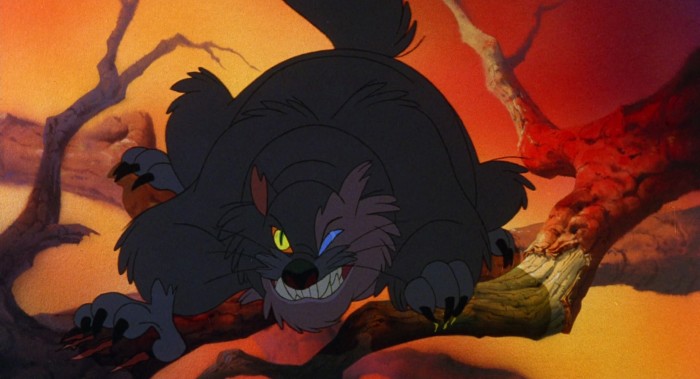'The Secret Of NIMH' Revisited: Does Don Bluth's Animated Classic Hold Up?
(Welcome to Nostalgia Bomb, a series where we take a look back on beloved childhood favorites and discern whether or not they're actually any good. In this edition, we revisit Don Bluth's The Secret of NIMH.)
I got the worst sunburn of my life the summer before first grade. Growing up fair-skinned on the beach gave me a lot of opportunities to come home lobster-red and wincing, but this particular time stands out both for the pain and for the remedy.
My skin crackled and hummed. Standing hurt. Sitting hurt. Lying down hurt. I could feel the heat radiating off me and the allover itchy sting, but I was finally able to fall asleep on a soft towel laid out on our living room floor thanks to a portable fan and a VHS tape of The Secret of NIMH. It was a literal comfort movie.
I have no idea when I first saw the story of Mrs. Brisby attempting to get her house out of dodge before plowing time. It was part of that foggy age of half-forming memories, which means NIMH feels like it's always existed.
I also have no idea how many times I've seen it, because Letterboxd wasn't around in 1989. At any rate, it was enough to burn out the VHS tape.
This movie mesmerized me as a child. It was dense and dangerous, carrying with it a heft that most other kids movies didn't even attempt. Other than falling totally silent whenever The Snuggle Bear commercials popped up, I gravitated toward weird work like Labyrinth and The Dark Crystal.
It took me rewatching NIMH for this article to understand why it was at the top of the list.
Mrs. Brisby Goes on an Adventure
I've been trying to puzzle out why The Secret of NIMH held such sway over me as a kid, and I think it comes down to the scope of its adventure, the vibrancy of its animation, and the awe that the fearful scenes instilled. Like many of its Disney rivals, it lays out the broken family stakes in the first sequence, introducing us to the four Brisby children (including the bed-ridden Timothy), the family's need to heave their cinder block house out of the path of the tractors, and Mrs. Brisby's status as a widow who is clumsy but steadfast in her dual roles as father and mother.
The film is solely about the mounting demands life places on her as a protector, but seeing all the children gives us a peek at the beating hearts that would be lost without her. It borrows a bit from the animated Robin Hood in that endeavor, with snotty, scared, sweet kiddos and the pneumonia-slammed one whose name causes everyone in the household to start whispering. Timmy's need to stay indoors for weeks or risk death anchors them to the physical home itself, denying them an easy escape across the field. Yet, rather beautifully, Mrs. Brisby responds to the massive task of transporting her entire home with the motherly matter-of-factness of her grocery list. It must get done, so she's going to get it done. What other choice does she have?
So we launch into the dangerous world of the farm: the vicious house cat Dragon (who's either a Maine Coon or life-threateningly overweight), the ghostly Great Owl, and the rose bush where the rats and the secret of NIMH reside. The initial scrap with Dragon is thrilling, intensified by a violin-slamming score which subsides to make room for the film's sole comic relief character, Jeremy the Crow (Dom DeLuise), to carry Mrs. Brisby to a tree hovel filled with bones and a gigantic owl who should, by all measure, eat Brisby and take a nice nap.
This is all before her main mission begins. What sticks with you is the sense of sacrifice inherent in every desperate step. Mrs. Brisby is told she's crazy to attempt what she's doing, and even as more dangers stack on top of her burdened body, she takes the fierce protection of her family as a matter of course. That means chasing down a murderous tractor, fighting that damned cat, risking her life to get help from The Great Owl, and throwing herself headlong into the internal politics of the NIMH rat faction.
A Sense of Danger
Throughout all of this, the artwork is stunning. Detailed in its depiction of the whooshing instruments of Mr. Ages, the local doctor, as well as the sprawling fields, the cobwebbed Great Owl sanctum, and the buzzing electric world of the rose bush, NIMH gorgeously combined American Gothic with psychedelic freak outs. The color palette was set several shades darker than the wistful primaries of Disney, reflecting the dark torment in the story. That may be unfair. Disney has done some unbelievably frightening things (hello, Pinocchio donkey nightmares), but there's something dangerous about NIMH. Something beyond childhood.
Maybe that's because it invades our world and injects a story about talking animals (so cute!) with an angry science fiction message of death and destruction. Yes, the most brilliant element of the movie (and the book, of course) is what the secret is. In the middle of this harrowing tale of a mother's sacrifice, a vast conspiracy with a Tolkien-esque name lies hidden in the thorny darkness of a rose bush where rats with supernatural powers (even beyond talking and wearing clothes) reside. The twist is that it's not magic: it's human. It's us. They're lab rats, and that fantasy-evoking name is actually the very real National Institute for Mental Health. In a world of mystic amulets and herbal home remedies, it's jaw-dropping to witness an invasion of real-world science. It's like if Frodo reached Mount Doom only to find a gray-haired woman in a lab coat explaining how she programmed the ring he's carrying after coding the Apple Watch.
The reveal was probably the first time a movie meant for me had a genuine twist to it, and it blew my tiny little mind.
Does It Hold Up?
So, so well. The Secret of NIMH is a masterpiece. It'd been years since I last watched it, and every scene feels vital to the story and every character feels like an old friend. What surprised me was how little there was to the adventure; I talked about scope earlier, but when you boil it down to the basics, Mrs. Brisby gets guidance from The Great Owl, meets the rats of NIMH, there's some cool tiny sword fighting, and then they (really, she) raise her home from the mud. Within that tight framework is a lot of endearing dialogue and a healthy dose of mini-battles and wacky nonsense from DeLuise's crow with two left talons.
I can't say I knew who Dom DeLuise was a kid (at least not until Robin Hood: Men in Tights), but it's fun to look back on his vocal performance here and appreciate how key he was to lifting the spirits of this movie. In playing clown for the Brisby children, he's also babysitting for the young audience, tacitly promising that the movie won't get too scary. Or, if it does, that they can handle it.
It was also fascinating to look back on this movie with adult, film critic eyes to remember an age where movie stars hadn't breached the world of voice acting yet. If NIMH were made today (ahem), Justin Timberlake would voice Jeremy and Amy Adams would voice Mrs. Brisby. This is a get-off-my-lawn type of thing, but there was something special about the pure characters that emerged from animation without star power audibly poking out from behind the cels.
NIMH is filled with actors whose names we might not recognize until we scope out their resumes. Most were Shakespearean stage players. Sir Derek Jacobi brought fantastic gravitas to Nicodemus, the wizened rat spirit guide who gifts Mrs. Brisby the amulet that she uses to save her family. Hermione Baddeley – a Tony winner who is probably most recognizable as one of the housekeepers in Mary Poppins – stole scenes as the cranky Auntie Shrew. Weirdly, the most recognizable names to the casual pop fans of my generation are Shannen Doherty and Wil Wheaton, who voiced the two older Brisby kids. That was a nice gem to uncover about a movie that I've never investigated beyond its final scene. As a child, the movie existed solely as story, and I can't explain why I've never been curious to know who voiced what character or who drew what scenes.
The exception to that is Don Bluth. The writer/director is an institution of darker-themed children's movies with outstanding animation. NIMH was his first feature after striking out on his own without Disney. It's tragic that his career has been most heavily marked by phenomenal movies that didn't make money. I'd like to believe that if he were launching today, he would find more success. With the success of LAIKA, Dreamworks, Ghibli, and Pixar, there is more room today for animated movies than in the monolithic Disney decades.
Comfort and Closure
Obviously, I can read more deeply into the movie as an adult to explain what I loved about it as a child (and love about it now). For example, I'm sure I never really noticed how the major villain (us, with experimental syringes) is mirrored in the opening by Timmy's sickness. The theme is a yarn ball of complication: we're watching sweet, talking animals who were given damning powers by human experimentation that was most likely in service of finding medicine for our own illnesses.
Mostly, the revisit gave me a chance to psychoanalyze myself as a child. I grew up with a terminally ill brother and parents passionately devoted to his health and survival, and even though I'd loved NIMH for years before his diagnoses, it's easy to see that I would have worn out the VHS copy afterward relating to the difficult story of a mother's fierce courage and overwhelming sacrifice in the face of a immovably sick child and the towering force steadily rolling toward their home.
It helped me get some relief on the day of my worst sunburn, and it helped me, undoubtedly, on many days after that.



